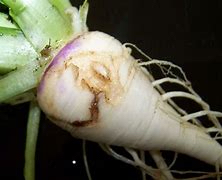The Problem
- Particularly destructive to early season plantings, they feed underground on succulent roots and attack a large variety of vegetable crops including radish, cabbage, carrot, turnip and onions.
- Heavily infested roots are often riddles with tunnels and rotted.
- Affected plants lack vigor, may be stunted or yellowed and often wilt during the heat of the day.
- In some cases, maggots may even chew through taproots, causing plants to die.
- Root maggots have a fairly rapid life cycle and can produce several generations in a single growing season.
Appearance:
- Adults (the only stage you can see before damage occurs) look like a slightly miniature version of the ordinary housefly.


- The maggots themselves are small — 1/4” or less — yellowish white larvae. They look a bit like fat grains of rice.
Signs of damage


Unfortunately, you probably won’t detect any signs of damage until harvest time when the crop you’ve tended to for weeks comes up riddled with tunnels and, quite probably, full of black rot.
Controls
- Row covers are one of the two the most effective way to control root maggots.
- These should be installed immediately after the seeds are sown since adult females are attracted for egg laying by the moisture emitted from newly disturbed soil.
- If row covers aren’t practical for your garden bed, you may want to consider root collars to prevent eggs from being deposited too near your seedlings.
- Small amounts of diatomaceous earth may be spread around seedling stems to deter egg laying adults.
- Yellow sticky traps placed around the garden bed may capture adult flies before they can mate and lay eggs.
- On the other hand, traps like this don’t discriminate between predators and pollinators.
- Beneficial nematodes can be top dressed around plants to prey on the larvae.
- Sanitation — cleaning up and properly disposing of dead plant material at the same time you are harvesting is the other “most effective way” of controlling root maggots.
- Plant waste infested by maggots should never be composted but should be disposed of in your yard waste bin. That way they are not going to develop into the next generation of egg-laying adults.
- Garlic as a companion plant has been suggested as a deterrent to root maggots.
